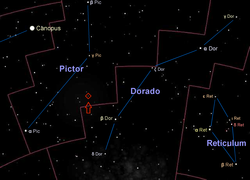| Observation data Epoch J2000.0 Equinox J2000.0 (ICRS) | |
|---|---|
| Constellation | Pictor [1] |
| Right ascension | 05h 54m 04.24050s [2] |
| Declination | −60° 01′ 24.4930″ [2] |
| Apparent magnitude (V) | 7.17 [3] |
| Characteristics | |
| Evolutionary stage | main sequence [2] |
| Spectral type | K2.5V [3] |
| B−V color index | 0.93 [3] |
| Astrometry | |
| Radial velocity (Rv) | 31.08±0.12 [2] km/s |
| Proper motion (μ) | RA: −52.174±0.023 mas/yr [2] Dec.: −60.059±0.025 mas/yr [2] |
| Parallax (π) | 77.3261±0.0170 mas [2] |
| Distance | 42.179 ± 0.009 ly (12.932 ± 0.003 pc) |
| Absolute magnitude (MV) | 6.57±0.01 [4] |
| Details | |
| Mass | 0.75+0.03 −0.04 [5] M☉ |
| Radius | 0.716±0.010 [6] R☉ |
| Luminosity (bolometric) | 0.23 [7] L☉ |
| Luminosity (visual, LV) | 0.20 [note 1] L☉ |
| Surface gravity (log g) | 4.47±0.16 [7] cgs |
| Temperature | 4,977±59 [7] K |
| Metallicity [Fe/H] | −0.31±0.03 [7] dex |
| Rotation | 31.8±6.7 d [8] |
| Rotational velocity (v sin i) | 3 [5] km/s |
| Age | 1.2 (≥ 0.2) [5] Gyr |
| Other designations | |
| CD−60 1303, CPD−60 508, GC 7474, GJ 2046, HIP 27887, PPM 355061, SAO 249388, 2MASS J05540421-6001245. [3] | |
| Database references | |
| SIMBAD | data |
| Exoplanet Archive | data |
| ARICNS | data |
HD 40307 is an orange (K-type) main-sequence star located approximately 42 light-years away in the constellation of Pictor (the Easel), taking its primary name from its Henry Draper Catalogue designation. It is calculated to be slightly less massive than the Sun. The star has six known planets, three discovered in 2008 [3] [9] and three more in 2012. One of them, HD 40307 g, is a potential super-Earth in the habitable zone, with an orbital period of about 200 days. This object might be capable of supporting liquid water on its surface, although much more information must be acquired before its habitability can be assessed. [10] [11] [12] [13]
Contents
- History and nomenclature
- Characteristics
- Distance and visibility
- Planetary system
- See also
- Notes
- References
- External links
No stellar companions to HD 40307 were detected as of 2018. [14]







